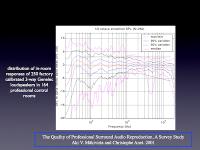- Thread Author
- #1
http://www.psaudio.com/pauls-posts/flat-vs-musical/
A good post by Paul McGowan. I have found that a little bump between 40-100hz can add nice body to the lower mids.
After several hours of measurements and tweaking speaker placement, here is me doing some final EQ'ing of Justin's Avantgarde Uno XD's in Boston this week. The ability to dial in the bass to the room is a nice advantage. The improvement was substantial if I do say so myself.

Now the question with some speakers (not ones you can adjust the bass), when does adding a bump become too much of a good thing and why do some designers add such a big boost in the lower mids? Do they test their speakers in a wide variety of rooms, with a wide variety of music and amplification? Not always I'm sure.
But when that boost becomes too much, the question is why did the designer do it? I believe it's based on the music THEY listen to. Adding a big boost in the lower mids (say 60-80hz), adds wonderful richness to the weightiness and tone of a cello for example in classical music, but it's a nightmare when that same listener puts on a jazz piece with stand up bass.
It's a delicate balance. Caution must be used so it doesn't become too much of a good thing.
Sent from my iPhone using Tapatalk
A good post by Paul McGowan. I have found that a little bump between 40-100hz can add nice body to the lower mids.
After several hours of measurements and tweaking speaker placement, here is me doing some final EQ'ing of Justin's Avantgarde Uno XD's in Boston this week. The ability to dial in the bass to the room is a nice advantage. The improvement was substantial if I do say so myself.

Now the question with some speakers (not ones you can adjust the bass), when does adding a bump become too much of a good thing and why do some designers add such a big boost in the lower mids? Do they test their speakers in a wide variety of rooms, with a wide variety of music and amplification? Not always I'm sure.
But when that boost becomes too much, the question is why did the designer do it? I believe it's based on the music THEY listen to. Adding a big boost in the lower mids (say 60-80hz), adds wonderful richness to the weightiness and tone of a cello for example in classical music, but it's a nightmare when that same listener puts on a jazz piece with stand up bass.
It's a delicate balance. Caution must be used so it doesn't become too much of a good thing.
Sent from my iPhone using Tapatalk

